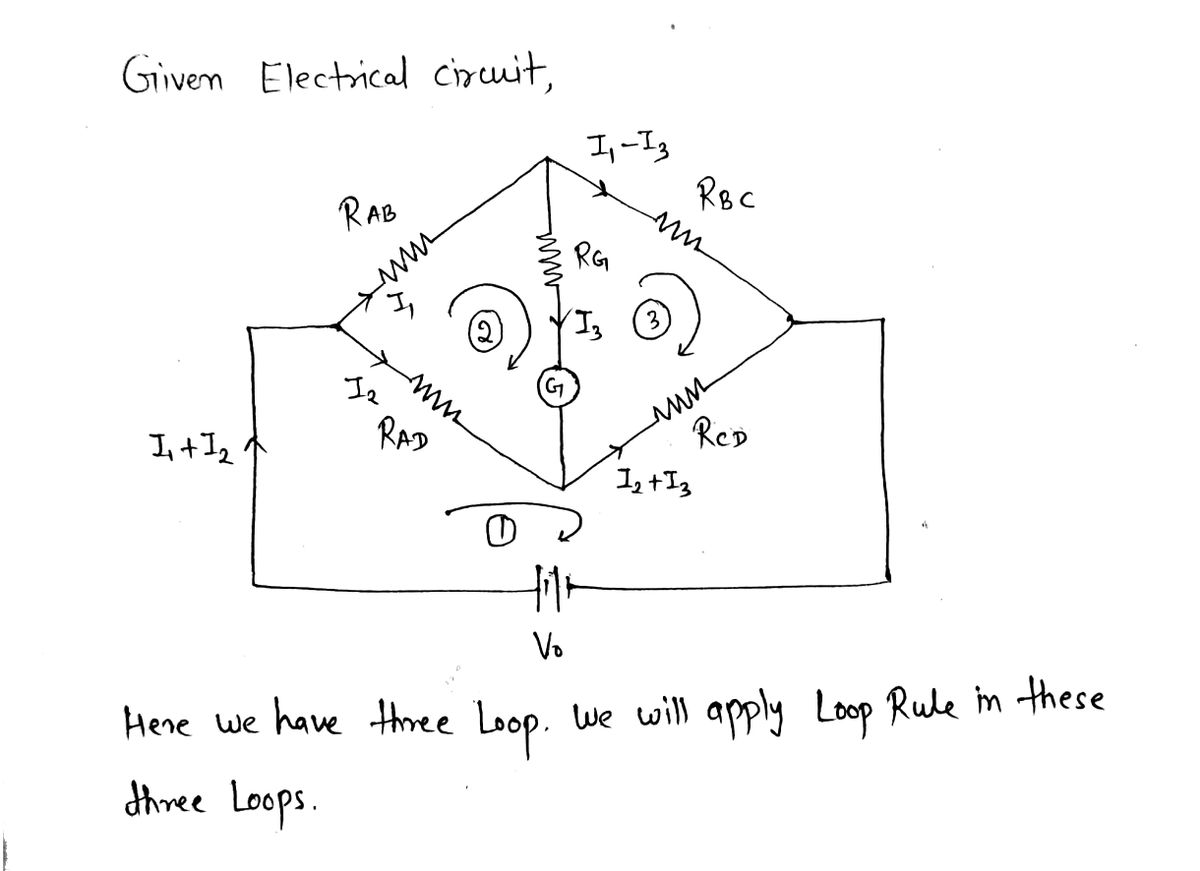Use Kirchhoff's junction rule and voltage/loop rule to find the current through each resistor in the following circuit: RAB = 10 Q, RBC = 15 Q, RAD = 6 Q, RCD = 12 Q, RG = 4 N, and V. = 10 V.
Use Kirchhoff's junction rule and voltage/loop rule to find the current through each resistor in the following circuit: RAB = 10 Q, RBC = 15 Q, RAD = 6 Q, RCD = 12 Q, RG = 4 N, and V. = 10 V.
College Physics
11th Edition
ISBN:9781305952300
Author:Raymond A. Serway, Chris Vuille
Publisher:Raymond A. Serway, Chris Vuille
Chapter1: Units, Trigonometry. And Vectors
Section: Chapter Questions
Problem 1CQ: Estimate the order of magnitude of the length, in meters, of each of the following; (a) a mouse, (b)...
Related questions
Question
Apply the Loop Rule to ABHDA.

Transcribed Image Text:Use Kirchhoff’s junction rule and voltage/loop rule to find the current through each resistor in the following circuit: \(R_{AB} = 10 \, \Omega\), \(R_{BC} = 15 \, \Omega\), \(R_{AD} = 6 \, \Omega\), \(R_{CD} = 12 \, \Omega\), \(R_{G} = 4 \, \Omega\), and \(V_o = 10 \, \text{V}\).
![The image depicts a Wheatstone bridge circuit, which is used to measure unknown electrical resistances. It consists of four resistors arranged in a diamond shape and a galvanometer.
### Explanation of the Diagram:
- **Points and Resistors:**
- **A, B, C, D:** These are the junction points of the circuit.
- **\(R_{AB}\), \(R_{BC}\), \(R_{CD}\), \(R_{AD}\):** These are the resistors in the circuit.
- **\(R_G\):** The resistor on the bridge between points B and D, connected through the galvanometer \(G\).
- **Current Flow:**
- **\(I_1\):** The current flowing from point A to point B.
- **\(I_2\):** The current flowing from point A to point D.
- **\(I_3\):** The current flowing through the galvanometer \(G\) from B to D.
- Arrows indicate the direction of the current.
- **Galvanometer (G):**
- Located between points B and D, it measures the current flowing through \(R_G\).
- **Voltage Source:**
- \(V_0\) represents the potential difference across the circuit, with positive and negative terminals located at points F and K, respectively.
### Usage of Wheatstone Bridge:
The Wheatstone bridge is balanced when \(I_3 = 0\), meaning no current flows through the galvanometer. This condition allows determination of the unknown resistor value by using the known values of the other resistors and the equation:
\[ \frac{R_{AB}}{R_{BC}} = \frac{R_{AD}}{R_{CD}} \]
This principle makes Wheatstone bridges essential tools in laboratories for precise resistance measurements.](/v2/_next/image?url=https%3A%2F%2Fcontent.bartleby.com%2Fqna-images%2Fquestion%2F1d93de19-418c-4f30-8c4a-2a6a3330d625%2F5f42508f-c7c8-4ff3-a20b-6fb4e3d7149b%2Fgh3zad8_processed.png&w=3840&q=75)
Transcribed Image Text:The image depicts a Wheatstone bridge circuit, which is used to measure unknown electrical resistances. It consists of four resistors arranged in a diamond shape and a galvanometer.
### Explanation of the Diagram:
- **Points and Resistors:**
- **A, B, C, D:** These are the junction points of the circuit.
- **\(R_{AB}\), \(R_{BC}\), \(R_{CD}\), \(R_{AD}\):** These are the resistors in the circuit.
- **\(R_G\):** The resistor on the bridge between points B and D, connected through the galvanometer \(G\).
- **Current Flow:**
- **\(I_1\):** The current flowing from point A to point B.
- **\(I_2\):** The current flowing from point A to point D.
- **\(I_3\):** The current flowing through the galvanometer \(G\) from B to D.
- Arrows indicate the direction of the current.
- **Galvanometer (G):**
- Located between points B and D, it measures the current flowing through \(R_G\).
- **Voltage Source:**
- \(V_0\) represents the potential difference across the circuit, with positive and negative terminals located at points F and K, respectively.
### Usage of Wheatstone Bridge:
The Wheatstone bridge is balanced when \(I_3 = 0\), meaning no current flows through the galvanometer. This condition allows determination of the unknown resistor value by using the known values of the other resistors and the equation:
\[ \frac{R_{AB}}{R_{BC}} = \frac{R_{AD}}{R_{CD}} \]
This principle makes Wheatstone bridges essential tools in laboratories for precise resistance measurements.
Expert Solution
Step 1

Step by step
Solved in 4 steps with 4 images

Recommended textbooks for you

College Physics
Physics
ISBN:
9781305952300
Author:
Raymond A. Serway, Chris Vuille
Publisher:
Cengage Learning

University Physics (14th Edition)
Physics
ISBN:
9780133969290
Author:
Hugh D. Young, Roger A. Freedman
Publisher:
PEARSON

Introduction To Quantum Mechanics
Physics
ISBN:
9781107189638
Author:
Griffiths, David J., Schroeter, Darrell F.
Publisher:
Cambridge University Press

College Physics
Physics
ISBN:
9781305952300
Author:
Raymond A. Serway, Chris Vuille
Publisher:
Cengage Learning

University Physics (14th Edition)
Physics
ISBN:
9780133969290
Author:
Hugh D. Young, Roger A. Freedman
Publisher:
PEARSON

Introduction To Quantum Mechanics
Physics
ISBN:
9781107189638
Author:
Griffiths, David J., Schroeter, Darrell F.
Publisher:
Cambridge University Press

Physics for Scientists and Engineers
Physics
ISBN:
9781337553278
Author:
Raymond A. Serway, John W. Jewett
Publisher:
Cengage Learning

Lecture- Tutorials for Introductory Astronomy
Physics
ISBN:
9780321820464
Author:
Edward E. Prather, Tim P. Slater, Jeff P. Adams, Gina Brissenden
Publisher:
Addison-Wesley

College Physics: A Strategic Approach (4th Editio…
Physics
ISBN:
9780134609034
Author:
Randall D. Knight (Professor Emeritus), Brian Jones, Stuart Field
Publisher:
PEARSON